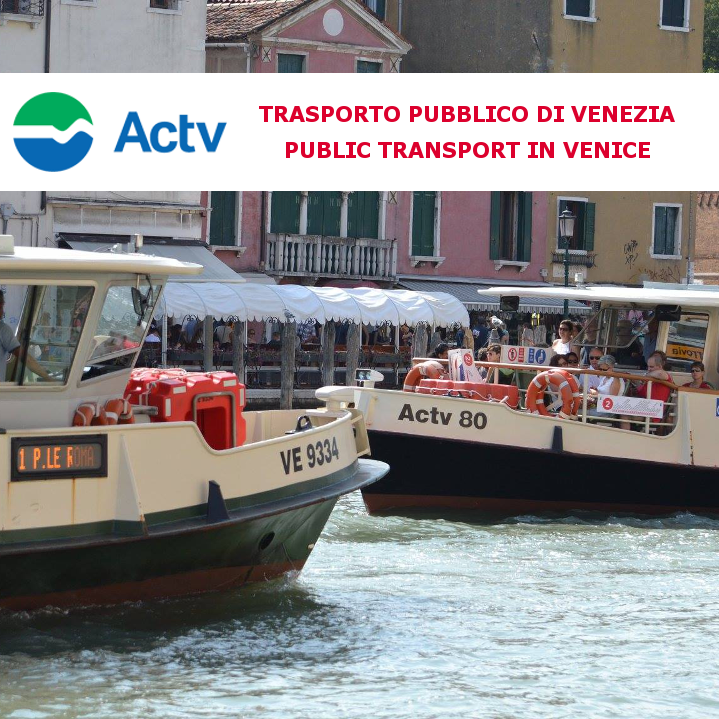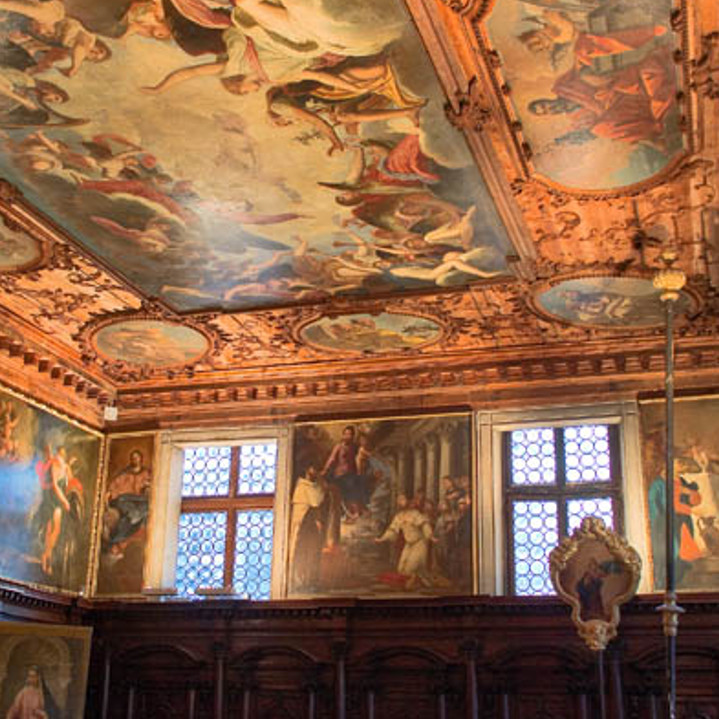You are here
Castello district
The Castello district occupies the entire eastern part of the city. It is largely characterized by the presence of the Arsenale, a vast complex that symbolizes the maritime power of the Venetian Republic.
The district also features very different urban areas: to the west of the Arsenale there is a densely populated area full of ancient monuments, while the area to the east of the Arsenale grew around the island of San Pietro, connected to the origins of the city and the ancient seat of the Cathedral of Venice, and the island of Sant'Elena, which is home to one of the newer districts built in the city.
This itinerary starts from the Arsenale and ends at the Rialto Bridge, the maritime and trading centre of the Republic. For logistical reasons, the island of San Pietro is excluded - the curious and attentive visitor can visit this island separately.
Opposite the Arsenale vaporetto landing is a dark brick red building with the battlements called “degli antichi Forni” ("of the ancient ovens"). Here savoury biscuits were packaged that the sailors of the Venetian fleet carried on board during long journeys. Next to this building there is the street of the same name (Calle Forni), long and narrow. Walking its entire length you arrive in Campo dell'Arsenale, presumably founded around 1150, the large naval shipyard where the galleys of the Venetian Republic were built. Its entrance portal was built in 1460 and is considered one of the first examples of the Renaissance style in Venice. It was enhanced with a loggia, allegorical statues and four lions laying on their sides, including the Lion of Piraeus, moved to Venice by the troops of Morosini after the capture of Athens (September 29, 1687) during the War of Morea .
Following the foundations on the left you come to the church of San Martino. The church was founded, according to tradition, at the beginning of the seventh century and rebuilt in 1545 by the architect Jacopo Sansovino. Its interior is very simple, including frescoes and Baroque and late Baroque decorations, among which stands the tomb of Doge Erizzo of 1633.
Cross the Ponte dei Penini, alongside the Rio de le Gorne, and admire again the Arsenale walls until you reach Campo de le Gorne, which takes its name from the numerous "Gorne" (gargoyles) which still exist. The well situated in the centre of the campo dates back to the fourteenth century. Continuing along Calle del Bastion and Calle de le Muneghette, you reach Campo do Pozzi, named after the presence at one time of two wells. Today there is only one, featuring a representation of the two ancient wells, together with the figure of San Martino and three angels, symbolizing the Holy Trinity.
Subsequent Calle del Forno and Calle degli Scudi make the route even more labyrinthine, ending finally in Campo de le Gate, whose name has nothing to do with the many cats that once populated Venice. The name refers to the papal legates who lived in the building of the nunciature. There is also an inscription stating that Ugo Foscolo lived in this "district" between 1792 and 1797.
First Detour
From Campo de le Gate proceed along Calle dei Furlani until you reach the ancient Church of St. John the Baptist and its convent, still the seat of the Order of the Knights of Malta, built on the site of the settlement of the Knights Templar, which passed to the Knights of St. John after the abolition of the Order of the Knights Templar (1313). The church, recently restored, is not always accessible, but one can always try.
Next to it stands the building of the Scuola Dalmata dei Santi Giorgio e Trifone, an ancient brotherhood which still exists, a real "living heritage" as well as the treasure chest of a famous series of paintings by Vittore Carpaccio which tells the stories of the three patron saints of this community. The Scuola Dalmata is regularly open to the public every day from 9.30am to 5.30pm, on Mondays only in the afternoon from 1pm.
Continuing along the Fondamenta dei Furlani until the Church of Sant'Antonin and then along the salizada (paved road) of the same name, you come to the Campo della Bragora, where you find the Church of San Giovanni Battista in Bragora, rich with paintings from the 15th and 16th centuries, a destination of pilgrimage for music lovers from around the world who come to stand before the font in which Antonio Vivaldi was baptized, himself a long-time member of the parish and music teacher at the nearby Ospedale della Pietà (orphanage).
Main route
If instead we proceed from the Campo delle Gate along the Salizzada delle Gate and the Salizzada di San Francesco and continue straight ahead, we begin to see the church of San Francesco della Vigna. The church was founded by Franciscan monks and takes its name, according to tradition, from the vineyard that Marco Ziani, the son of the Doge Pietro Ziani, donated to the friars. The building was constructed on the site where, according to legend, St. Mark stopped on his return from Aquileia. It is said that the evangelist had found refuge there after a storm, and that an angel had appeared in a dream who spoke the following words: "Pax tibi Marce Evangelista Meus" to prophesy that one day his body would find eternal rest in the islands of the lagoon.
In 1534 the Doge Andrea Gritti laid the foundation stone of the new church, which was designed by two of the most famous architects of that time: Sansovino and Palladio. The interior with a single nave is divided into numerous side chapels belonging to noble families who embellished them with works of great artistic value, such as the numerous Madonnas with Child and Saints by Negroponte, Giovanni Bellini and Paolo Veronese. Also of great interest are the fifteenth and sixteenth century cloisters.
Opposite the church is the Palazzo della Nunziatura Apostolica, a sixteenth-century building originally owned by the Gritti family, purchased by the government of the Venetian Republic in 1564 and later donated to Pope Pius IV and used as a residence of the apostolic nuncios. The colonnade connecting the structure to house is more recent.
Calle di San Francesco emerges into Fondamenta Santa Giustina, where stands the church of Santa Giustina, now part of a school complex, dedicated to the saint upon whose day (17 October 1571) the Venetians won the battle of Lepanto against the Turks.
From these foundations, cross the bridge and follow the salizada to Campo Santa Giustina. Then take Calle del Cafetier, whose name derives from an old coffee shop that was located here. Next, take Barbaria de le Tole. The street takes its name from the many lumber warehouses located there from ancient times. Towards the end of Barbaria you can admire the baroque façades of the church of Santa Maria dei Derelitti (Ospedaletto). The façade is bizarre and impressive, difficult to appreciate unless you stop directly in front of it, along the narrow street. The church was built between 1662 and 1674 by Giuseppe Sardi and Baldassare Longhena. The works in its interior date back to the seventeenth and eighteenth centuries, and among them there are the "The Annunciation" by Jacopo Palma the Younger and the "Sacrifice of Isaac", an early work by Giambattista Tiepolo. The eighteenth-century music hall may be visited upon request. See: http://www.scalacontarinidelbovolo.com/sala-della-musica/
Continuing onwards we arrive in the beautiful Campo dei Santi Giovanni e Paolo, dominated by the Gothic church of the same name. The construction of the church was begun in 1246 by the Dominican friars on marshy land donated to them in 1234 by the Doge Jacopo Tiepolo after a vision he saw in a dream. A true monument to the civilian and military history of the Republic. Inside many Doges, naval Captains and military commanders are buried. Among the paintings to remember: The Pala di San Vincenzo Ferreri by Giovanni Bellini (circa1465), Sant' Antonino che distribuisce le elemosine by Lorenzo Lotto, in addition to works by Veronese in the Chapel of the Rosary.
Alongside stands the Scuola Grande di San Marco, a work Lombardo and Buora (1487 - 1490) and, in part, Codussi (1495), former seat of a devotional confraternity, now part of the Ospedale Civile di Venezia and headquarters of the museum of surgical instruments and an old pharmacy. Both can be visited (http://www.scuolagrandesanmarco.it/).
At the centre of the campo is the equestrian statue of Bartolomeo Colleoni, sculpted by Andrea Verrocchio in the late fifteenth century. The reason that the statue is located in this place is curious. Colleoni, a military commander from Bergamo in the service of the Republic of Venice, left, at his death, most of his wealth to the Republic on the condition that he had a monument dedicated to himself in Piazza San Marco. This was forbidden by the statutes of the city and the monument was thus erected in front of the Scuola di San Marco, which bore the same name.
Cross the bridge that leads to Calle Larga Gallina and the Fondamenta Piovan, and proceed along the border between the districts of Castello and Cannaregio. To the left is the Santa Maria Nova bridge which leads to the admirable façade of one of the most picturesque and popular Venetian churches: Santa Maria dei Miracoli. This church, completed in 1489 by Pietro Lombardo and decorated with elegant coloured marble, was built to house a painting of the Virgin with the Child in 1404, considered miraculous by the locals and therefore worthy of having an appropriate place in which to be adored.
Hours: see http://www.chorusvenezia.org/
Turn left into Calle Castelli and you arrive at foundations on the left where you can admire the beautiful wooden door of the late-Gothic Palazzo Soranzo-Van Axel. It runs along the foundations crossing the Ponte del Cristo and you arrive in Campo Santa Marina, whose church stood where now there are dwellings numbered 6067 and 6068. Every year the Doge, on the Saint’s day (17 July), visited the church in memory of the recapture of Padua, lost during the war waged in Venice by the league of Cambrai (1509). Soon we are back in the Castello district.
Cross the campo diagonally, and take the Soteportego Scaleta. At the end of the homonymous street, after the bridge, you enter Corte Seconda del Milion, and are again in Cannaregio. The court is famous because it corresponds to the location of the thirteenth-century home of Marco Polo and his family. To remind us of ancient times there are precious remnants of Venetian-Byzantine architecture (XI and XII century). Through a magnificent archway with marble decorations of the eleventh and twelfth centuries you reach the Teatro Malibran, so named in 1834 in honour of the famous singer. It was built in 1667 by the Grimani family who managed three theatres in the city.
Continue along Calle del Teatro and you reach the Church of San Giovanni Crisostomo. Erected in 1497 from a design by Tullio Lombardo, with Greek cross interior, the church was named after the patriarch of Constantinople, famous for his orations, and was built by Mauro Codussi, an architect from Lombardy who introduced the architecture of the Renaissance in Venice. Among the most important works to be remembered: "San Girolamo" by Giovanni Bellini, his last work, and "San Giovanni Crisostomo e Santi" by Sebastiano del Piombo. Hours: daily from 7am to 7pm.
Turn left along Salizada San Giovanni Crisostomo. After the bridge there is the famous Fontego dei Tedeschi. The old building, which was destroyed by a major fire in 1505, was used as an emporium and homes by German merchants while they were in Venice on business. It was immediately rebuilt at the expense of the Venetian state. It became famous for its fresco decorations. The façade on the Grand Canal (on Calle dal Tiziano) was created by Giorgione. Today there remain only two preserved fragments, one at the Accademica, the other at the Cà d'Oro.
Skirting the building you reach Campo San Bartolomeo with its eponymous church which, almost invisible, still stands today. The piazza was enlarged by demolishing some houses in 1858 and in 1883 the statue of Goldoni that stands at its centre was inaugurated. Remarkable is the façade of the Palazzo Moro which dates back to 1300.
This concludes our itinerary. On the right, at the foot of the Rialto Bridge, is the landing point.
Itinerario a cura di:






